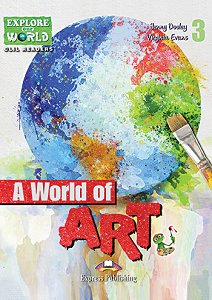From STEM to STEAM
If you have been active in teaching over the last years, chances are that you are aware of STEM.
Standing for Science, Technology, Engineering, and Math, STEM aims at interweaving the disciplines mentioned to a single lesson. Due to this 360o approach, STEM offers a richer learning experience, while developing the students’ intellectual curiosity and critical thinking skills.
Until recently, STEM approaches ruled educational research and practice. Indeed, many regarded technical competence as the guarantee of success in the workplace, and, at the same time, graduates of Social Sciences, Arts, and Humanities were considered to be less employable, less skilled, less-you-name-it.
However, the tide has turned: as we acknowledge the significance of humanities again, STEM gets extended to include the Arts—and here comes its successor: STEAM!
Enriched with dance, drama, painting, crafting, and design, STEAM places creativity, innovation, and communication at the heart of its approach and equips students with skills essential for the Industry 4.0 era.
Why choose STEAM?
Interdisciplinary, diverse, experiential: there are good reasons behind STEAM’s hype. By bringing values and principles that govern science, technology, engineering, arts, and mathematics together, students become adept at problem-solving, team work, and conscious risk-taking.
At the same time, as inquiry is woven into STEAM, students are encouraged to ask their own questions and provide their own answers.
Other reasons to set off the STEAM mission:
◗ Making associations between concepts is inherent to humans. On the other hand, cross-curricular approaches help students focus and understand better the information presented.
◗ Integrated learning makes school more interesting and relevant.
◗ Hands-on learning is better than learning through textbooks; at the same time, it allows better insights and encourages transparency and a better comprehension of topics;
◗ STEAM approaches open access to peer-driven learning experiences and collaboration.
How to: Scaffolding your STEAM-powered lesson
No matter what subject you teach, you should scaffold your STEAM-powered lesson in the following way:
Before the class:
- Understand how a given topic relates to STEAM and identify the reasons that it should be STEAM-approached;
- Address the issue at stake and break it down in questions related to the disciplines of interest;
- Pin down the areas or skills students need input on and plan on providing guidance;
During the class:
- Present the task;
- Have students brainstorm and work on their project;
- Provide input and guidance;
- Have students present their findings and suggested courses of action;
- Give feedback and ask students to modify their projects accordingly.
True or False? Understanding STEAM
If I ask students to draw a picture, I will have worked on the Arts component.
False!
In fact, it should always be clear that we should treat each discipline with respect and exploit it meaningfully.
That being said, do not let anxiety take the best of you: introduce STEAM activities gradually without worrying too much about including all five elements into your lesson; opt for two components, but keep it meaningful.
STEAM is too hard for junior classes.

The iWonder series motivates young learners and ensures that they develop a love of learning that is never-ending!
False!
iWonder 2, for instance, is designed for young students who have recently embarked on their learning journey.
At Module 2, their teacher instructs them to design, build, and test the resilience of a bridge, whereas the Arts also come into play through music. Paired with the Level 2 Readers Explore our World, iWonder can turn English into a fun, whole-brain learning experience that makes the most of young learners’ curiosity.
I can incorporate STEAM elements in my lessons, even if the curriculum does not feature the approach.
True!
STEAM does require thorough planning, but this does not equal to lengthy projects or topics your class would not work on, anyway.

Light and Shadows: iWonder 4 brings together Science and English.
I can connect STEAM to EFL and ESL
True!
You can interweave literature—hello, readers!—and linguistics into STEAM, indeed.
Inquiry-based instruction, visual thinking strategies, and reciprocal teaching can be efficient vehicles that carry both STEAM and literacy in order to teach content (the topics students get familiar with) and processes (the ways students learn).
With inquiry-based learning, students form question, find the answers, and reflect on the results of their inquiries. According to Dr. Robyn M. Gillies, inquiry-based learning adopts an “investigative approach to teaching and learning where students are provided with opportunities to investigate a problem, search for possible solutions, make observations, ask questions, test out ideas, and think creatively and use their intuition.”

A World of Art takes a look at different art forms and explores the many ways artists express themselves!
Visual thinking Strategies (VTS) encourage discovery, as students reflect, ask questions, provide answers, and actively involve students in the learning process.
One visual thinking strategy you can use is to ask learners to look at a work of art and answer questions such as the following:
- What do you think is going on?
- What makes you say that?
- What more can we find?
Reciprocal teaching, on the other hand, is all about using comprehension strategies to create insightful conversations on texts.

The Tundra Biome invites students to a trip to the Arctic tundra, a land of ice and snow.
To begin, ask students to predict the course of events or the outcome of a situation. Then, ask some guiding questions and divide students into brainstorming groups. Students can then point out elements that they don’t understand. They can then research answers to these questions, address their peers’ questions, and summarize their findings.
Let’s illustrate the above with the Tundra Biome CLIL Reader in mind:
The Tundra Biome CLIL Reader takes us on a trip to the Arctic Tundra and explores the place’s history, the stories of the locals, myths, and facts. A STEAM-based lesson based on the reader could feature a wide range of activities: storytelling to better understand the people and their lifestyle, cartography projects, or a classification of the fauna and the flora presented.
Last but not least, If your lesson involves the consolidation of grammar structures, robotics and coding can be exploited: for instance, Micro:Bit devices have been used as a way to fully comprehend grammar structures by associating standard structures with code writing.














